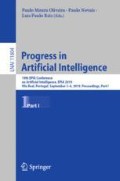Abstract
In this paper we discuss the development of agents for the Geometry Friends game, which poses simultaneously problems of planning and motion control in an physics-based puzzle and platform 2D world. The game is used in a competition, held yearly, that challenges participants to solve single player and cooperative levels. Our work addresses the two. The approach followed uses Rapidly-Exploring Random Trees with strategies to accelerate the search. When comparing with other agents on the competition, our results show that our agents can solve the single player challenges without overspecialization and are also promising for the cooperative levels with either agent-agent and human-agent players.
Access this chapter
Tax calculation will be finalised at checkout
Purchases are for personal use only
References
Bradshaw, J., Feltovich, P., Matthew, J.: Human-agent interaction. In: Boy, G. (ed.) Handbook of Human-Machine Interaction, pp. 283–302. Ashgate Publishing Ltd., Farnham (2011)
Bruce, J., Veloso, M.: Real-time randomized path planning for robot navigation. In: IEEE/RSJ International Conference on Intelligent Robots and Systems (IROS), vol. 3, pp. 2383–2388 (2002). https://doi.org/10.1109/IRDS.2002.1041624
Bruce, J., Veloso, M.: Real-time randomized motion planning for multiple domains. In: Lakemeyer, G., Sklar, E., Sorrenti, D.G., Takahashi, T. (eds.) RoboCup 2006. LNCS (LNAI), vol. 4434, pp. 532–539. Springer, Heidelberg (2007). https://doi.org/10.1007/978-3-540-74024-7_55
Hoffman, G., Breazeal, C.: Collaboration in human-robot teams. In: Proceedings of the AIAA 1st Intelligent Systems Technical Conference, pp. 1–18 (2004). https://doi.org/10.2514/6.2004-6434
Kraus, S.: Human-agent decision-making: combining theory and practice. Electron. Proc. Theoret. Comput. Sci. 215, 13–27 (2016). https://doi.org/10.4204/EPTCS.215.2
LaValle, S.M.: Rapidly-exploring random trees: a new tool for path planning. Technical report, TR 98-11 (1998). https://doi.org/10.1.1.35.1853
LaValle, S.M., Kuffner, J.J.: Rapidly-exploring random trees: progress and prospects, pp. 293–308 (2000) https://doi.org/10.1017/CBO9781107415324.004
Prada, R., Lopes, P., Catarino, J., Quiterio, J., Melo, F.S.: The geometry friends game AI competition. In: Proceedings of 2015 IEEE Conference on Computational Intelligence and Games, CIG 2015, pp. 431–438 (2015)
Soares, R., Leal, F., Prada, R., Melo, F.: Rapidly-exploring random tree approach for geometry friends. In: Proceedings of 1st International Joint Conference of DiGRA and FDG (2016)
Van Wissen, A., Gal, Y., Kamphorst, B.A., Dignum, M.V.: Human-agent teamwork in dynamic environments. Comput. Hum. Behav. 28(1), 23–33 (2012). https://doi.org/10.1016/j.chb.2011.08.006
Weibel, D., Wissmath, B., Habegger, S., Steiner, Y., Groner, R.: Playing online games against computer- vs. human-controlled opponents effects on presence, flow, and enjoyment. Comput. Hum. Behav. 24(5), 2274–2291 (2008). https://doi.org/10.1016/j.chb.2007.11.002
Zickler, S., Veloso, M.: Efficient physics-based planning: sampling search via non-deterministic tactics and skills. In: The 8th International Conference on Autonomous Agents and Multiagent Systems, pp. 27–34 (2009)
Zickler, S., Veloso, M.: Variable level-of-detail motion planning in environments with poorly predictable bodies. Frontiers Artif. Intell. Appl. 215, 189–194 (2010). https://doi.org/10.3233/978-1-60750-606-5-189
Acknowledgements
This work was supported by national funds through Fundação para a Ciência e a Tecnologia (FCT-UID/CEC/50021/2019) and through the project AMIGOS (PTDC/EEISII/7174/2014).
Author information
Authors and Affiliations
Corresponding author
Editor information
Editors and Affiliations
Rights and permissions
Copyright information
© 2019 Springer Nature Switzerland AG
About this paper
Cite this paper
Salta, A., Prada, R., Melo, F. (2019). Solving Motion and Action Planning for a Cooperative Agent Problem Using Geometry Friends. In: Moura Oliveira, P., Novais, P., Reis, L. (eds) Progress in Artificial Intelligence. EPIA 2019. Lecture Notes in Computer Science(), vol 11804. Springer, Cham. https://doi.org/10.1007/978-3-030-30241-2_8
Download citation
DOI: https://doi.org/10.1007/978-3-030-30241-2_8
Published:
Publisher Name: Springer, Cham
Print ISBN: 978-3-030-30240-5
Online ISBN: 978-3-030-30241-2
eBook Packages: Computer ScienceComputer Science (R0)

